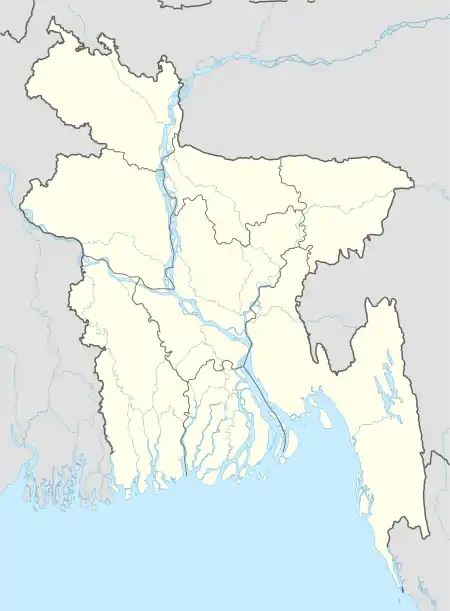Bhasan Char
Bhasan Char (Bengali: ভাষাণচর), also known as Char Piya, is an island in Hatiya Upazila, Bangladesh.[1] It is located in the Bay of Bengal, about 6 kilometres (3.7 mi) from Sandwip island and 37 miles (60 km) from the mainland.[2]
| Native name: ভাষাণচর | |
|---|---|
 Bhasan Char | |
| Geography | |
| Location | Bay of Bengal |
| Coordinates | 22°22′30″N 91°23′33″E |
| Area | 15 sq mi (39 km2) |
| Administration | |
| Division | Chittagong Division |
| District | Noakhali District |
| Upazila | Hatiya Upazila |
| Additional information | |
| Time zone |
|
The island was formed by Himalayan silt in 2006.[1] It spans 40 square kilometres (15 sq mi; 4,000 ha).[3] The Government of Bangladesh plans to construct a total of 1,440 buildings, including 120 cyclone shelters, to relocate 100,000 Rohingya refugees from the mainland camps of Cox's Bazar.[4] The Government of Bangladesh first suggested resettling Rohingya refugees on the island in June 2015.[5] The proposal was characterized by the United Nations Refugee Agency as "logistically challenging".[5] On January 26, 2017, the Bangladeshi government ordered their resettlement nonetheless.[1][2][6] Human Rights Watch called it "a human rights and humanitarian disaster in the making".[1]
In August 2019, the government announced an expansion of the Ashrayan Project (Ashrayan-3), to build 100,000 homes.[7] The houses are built four feet above the ground, in order to protect the refugees from high tidal waves.[8] The public works have amounted to 309.5 million takas, a 34% increase from the initial allocation.[9] The additional projects include raising the embankment from 9 feet (2.7 m) to 19 feet (5.8 m), and construction of cluster villages, shelter stations, water channeling infrastructure, roads and land development, in addition to the existing 26 works under the project.[9]
In January 2020, the project was moving forward despite opposition from Rohingya leaders and human rights groups. Bangladesh's minister for refugee affairs stated the island is "ready for habitation", though he gave no timetable for the relocation. The government has not permitted foreign journalists or Rohingya leaders to travel to Bhasan Char.
Since December 2020, around 4000 Rohingya had already been sent to this remote island. On January 29, 2021, 1,778 Rohingya refugees started their journey to this island. A fourth batch of refugees would be sent on January 30, 2021 according to the Bangladesh Authority. The process of shifting Rohingya refugees will continue until 100,000 have arrived in the island. [10]
References
- Kullab, Samya (February 23, 2017). "The Trouble With Thengar Char". Foreign Affairs. Retrieved February 25, 2017.
- Pokhare, Sugam; Westcott, Ben (January 31, 2017). "Thousands of Rohingya refugees may be sent to remote island". CNN. Retrieved February 25, 2017.
- "UN rapporteur visits Bangladeshi island chosen for Rohingya relocation". efe.com. January 24, 2019. Retrieved March 17, 2019.
- "A remote home for the Rohingya". Reuters. Retrieved Dec 5, 2020.
- "UN concern at Bangladesh plan to move thousands of Rohingya to flooded island". The Guardian. June 14, 2015. Retrieved February 25, 2017.
- Rahman, Shaikh Azizur (February 2, 2017). "Plan to move Rohingya to remote island prompts fears of human catastrophe". The Guardian. Retrieved February 25, 2017.
- Khokon, Sahidul Hasan. "Bangladesh: Govt takes up Ashrayan-3 project to shelter Rohingya refugees". India Today. Retrieved 1 August 2019.
- "Inside the Bhashan Char plan for Rohingyas". Dhaka Tribune. January 29, 2019. Retrieved 2019-11-22.
- "Bhasan Char project cost to rise 34%". The Business Standard. 2019-12-16. Retrieved 2019-12-19.
- "Will thousands of Rohingya refugees be sent to a remote island?". Los Angeles Times. January 23, 2020. Retrieved February 5, 2020.